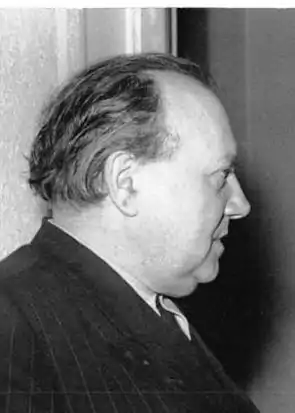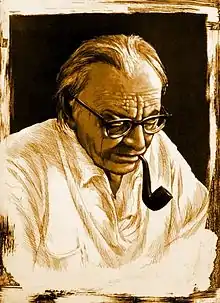Gottbegnadeten list
The Gottbegnadeten-Liste ("God-gifted list" or "Important Artist Exempt List") was a 36-page list of artists considered crucial to Nazi culture. The list was assembled in September 1944 by Joseph Goebbels, the head of the Ministry of Public Enlightenment and Propaganda, and Germany's supreme leader Adolf Hitler.

History
The list exempted the designated artists from military mobilisation during the final stages of World War II. Each listed artist received a letter from the Nazi Propaganda Ministry which certified his or her status. A total of 1,041 names of artists, architects, music conductors, singers, writers and filmmakers appeared on the list. Of that number, 24 were named as especially indispensable; they thus became the equivalent of National Socialism's "national treasures".
Goebbels included about 640 motion picture actors, writers and directors on an extended version of the list. They were to be protected as part of his propaganda film efforts, which persisted through the end of the war (and culminating in the expensive final UFA production Kolberg, released in January 1945).
Many of the cultural figures appearing on the list are no longer widely remembered but there are exceptions, including a number of renowned classical musicians such as the composers Richard Strauss, Hans Pfitzner, Carl Orff and Norbert Schultze, the orchestral conductors Wilhelm Furtwängler and Herbert von Karajan, and the Wagnerian baritone Rudolf Bockelmann. The only foreigner (Ausländer) on the list was Dutch actor Johannes Heesters.[1]
Special listed artists
Architects
- architect Leonhard Gall (1884–1952), "Reichskultursenator"
- architect Hermann Giesler (1898–1987), "Reichskultursenator"
- architect Wilhelm Kreis (1873–1955)
- architect and critic Paul Schultze-Naumburg (1869–1949)
Visual artists

- sculptor Arno Breker (1900–1991), named as "Reichskultursenator" (Reich Culture Senator)
- sculptor Fritz Klimsch (1870–1960)
- sculptor Georg Kolbe (1877–1947)
- sculptor Josef Thorak (1889–1952)
- painter and illustrator Hermann Gradl (1883–1964)
- history painter Arthur Kampf (1864–1950)
- painter Willy Kriegel (1901–1966)
- painter Werner Peiner (1897–1984)
Authors
- Gerhart Hauptmann (1862–1946)
- Hans Carossa (1878–1956)
- Hanns Johst (1890–1979), "Reichskultursenator"
- Erwin Guido Kolbenheyer (1878–1962)
- Agnes Miegel (1879–1964)
- Ina Seidel (1885–1974)
Composers


- Richard Strauss (1864–1949)
- Hans Pfitzner (1869–1949)
- Carl Orff (1895–1982)
- Werner Egk (1901–1983)
Actors
- Otto Falckenberg (1873–1947)
- Gustaf Gründgens (1899–1963)
- Johannes Heesters (1903–2011)
- Friedrich Kayßler (1874–1945)
- Eugen Klöpfer (1886–1950)
- Hermine Körner (1878–1960)
- Heinz Rühmann (1902–1994)
- Heinrich Schroth (1871–1945)
Singers
- Rudolf Bockelmann (1892–1958)
- Josef Greindl (1912–1993)
- Heinrich Schlusnus (1888–1952)
- Wilhelm Strienz (1899–1987)
Further listed artists on the "Führerliste"
There was also an extended list, the so-called "Führerliste" that included "God-gifted artists" who were not to be drafted but worked as "Künstler im Kriegseinsatz" (artists in the war effort).
Authors
- Hans Friedrich Blunck (1888–1961)
- Bruno Brehm (1892–1974)
- Hermann Burte (1879–1960)
- Friedrich Griese (1890–1975)
- Emil Strauß (1866–1960)
- Josef Weinheber (1892–1945)
- Heinrich Zillich (1898–1988)
- Gustav Frenssen (1863–1945)
- Hans Grimm (1875–1959)
- Max Halbe (1865–1944)
- Heinrich Lilienfein (1879–1952)
- Börries Freiherr von Münchhausen (1874–1945)
- Wilhelm Schäfer (1868–1952)
- Wilhelm von Scholz (1874–1969)
- Lulu von Strauss und Torney (1873–1956)
- Helene Voigt-Diederichs (1875–1961)
Composers

- Gerhard Frommel (1906–1984)
- Kurt Hessenberg (1908–1994)
- Karl Höller (1907–1987)
- Max Trapp (1887–1971)
- Hermann Zilcher (1881–1948)
- Mark Lothar (1902–1985)
- Johann Nepomuk David (1895–1977)
- Harald Genzmer (1909–2007)
- Ottmar Gerster (1897–1969)
- Paul Höffer (1895–1949)
- Joseph Marx (1882–1964)
- Gottfried Müller (1914–1993)
- Ernst Pepping (1901–1981)
- Fried Walter (1907–1996)
Conductors

- Hermann Abendroth (1883–1956)
- Hermann Diener (1897–1955)
- Karl Elmendorff (1891–1962)
- Wilhelm Furtwängler (1886–1954) (removed on December 7, 1944 because of his relationships with German resistance.[2])
- Robert Heger (1886–1978)
- Oswald Kabasta (1896–1946)
- Herbert von Karajan (1908–1989)
- Johannes Schüler (1894–1966)
- Karl Böhm (1894–1981)
- Eugen Jochum (1902–1987)
- Hans Knappertsbusch (1888–1965)
- Joseph Keilberth (1908–1968)
- Rudolf Krasselt (1879–1954)
- Clemens Krauss (1893–1954)
- Hans Schmidt-Isserstedt (1900–1973) [30]
- Paul Schmitz (1898–1992)
- Carl Schuricht (1880–1967)
Instrumentalists

- Ludwig Hoelscher (1907–1996), cellist
- Elly Ney (1882–1968), pianist
- Hans Beltz (1897–1977), pianist and musical pedagogue
- Walter Morse Rummel (1887–1953), pianist
- Günther Ramin (1898–1956), organist and choirmaster
- Walter Gieseking (1895–1956), pianist
- Wilhelm Stross (1907–1966), violinist
- Gerhard Taschner (1922–1976), violinist
Theater and opera

- Raoul Aslan (1886–1958),director and actor
- Jürgen Fehling (1885–1968), director and actor
- Heinrich George (1893–1946), actor
- Werner Krauß (1884–1959), actor
- Karl-Heinz Stroux (1908–1985), actor and director
- Heinrich Schlusnus (1888–1952), singer
- Wilhelm Strienz (1899–1987), singer
- Paula Wessely (1907–2000), actress
Fine Arts

- Claus Bergen (1885–1964), marine painter
- Ludwig Dettmann (1865–1944), war painter (member of the Berlin Secession)
- Fritz Mackensen (1866–1953), painter
- Franz Stassen (1869–1949), painter
- Kurt Edzard (1890–1972), sculptor
- Clemens Klotz (1886–1969), architect
- Fritz von Graevenitz (1892–1959), sculptor and painter
- Alfred Mahlau (1894–1967), painter
- Ernst Neufert (1900–1986), architect
- Bruno Paul (1874–1968), architect
- Richard Scheibe (1879–1964), sculptor
- Joseph Wackerle (1880–1959), sculptor
Special film-list initiated by Goebbels
- Wolf Albach-Retty (1908–1967)
- Willy Fritsch (1901–1973)
- Attila Hörbiger (1896–1987)
- Viktor de Kowa (1904–1973)
- Harry Piel (1892–1963)
- Hans Albers (1891–1960)
- Karl Dannemann (1896–1945)
- O. W. Fischer (1915–2004)
- Hans Holt (1909–2001)
- Paul Hörbiger (1894–1981)
- Ferdinand Marian (1902–1946)
See also
References
- Klee, Ernst (2007). Das Kulturlexikon zum Dritten Reich: Wer war was vor und nach 1945 (in German). Frankfurt am Main: Fischer. p. 227. ISBN 978-3-10-039326-5.
- Roncigli, Audrey (2009). Le cas Furtwängler. Paris: Imago. p. 171.
- Maximilian Haas: Die Gottbegnadeten-Liste (BArch R 55/20252a) in: Juri Giannini, Maximilian Haas und Erwin Strouhal (Hrsg.): Eine Institution zwischen Repräsentation und Macht. Die Universität für Musik und darstellende Kunst Wien im Kulturleben des Nationalsozialismus. Mille Tre Verlag, Vienna 2014, pp. 239–276. ISBN 978-3-900198-36-7.
